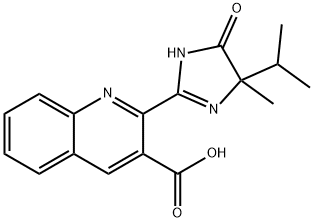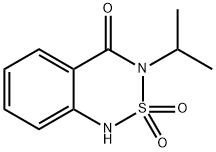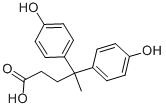Imazaquin acid
- CAS NO.:81335-37-7
- Empirical Formula: C17H17N3O3
- Molecular Weight: 311.34
- MDL number: MFCD00778521
- SAFETY DATA SHEET (SDS)
- Update Date: 2024-12-18 14:08:52

What is Imazaquin acid ?
The Uses of Imazaquin acid
Agricultural chemical.
Definition
ChEBI: 2-[4-methyl-5-oxo-4-(propan-2-yl)-4,5-dihydro-1H-imidazol-2-yl]quinoline-3-carboxylic acid is a quinolinemonocarboxylic acid that is quinoline-3-carboxylic acid which is substituted by a 4-methyl-5-oxo-4-(propan-2-yl)-4,5-dihydro-1H-imidazol-2-yl group at position 2. It is a quinolinemonocarboxylic acid, an imidazolone and a monocarboxylic acid.
Hazard
Moderately toxic by ingestion and skin contact. Low toxicity by inhalation.
Pharmacology
Plant Metabolism. The selectivity of imazaquin is due to
differential rates and routes of metabolism in tolerant
crops versus susceptible weeds (3). The primary
metabolite in soybeans is a pyrroloquinoline acetamide
(41, Fig. 18), which is immobile in the plant and is not
an inhibitor of acetolactate synthase. This metabolite is
further broken down to eventually yield a dicarboxylic acid.
Animal Metabolism. Metabolism studies in the rat
showed that they rapidly excreted unchanged imazaquin
in the urine (5). There was no accumulation of imazaquin or any of its derivatives in the liver, kidney, muscle,
fat, or blood. There was no detectable residue in the
liver, kidney, muscle, or fat of lactating goats and
laying hens, which were fed imazaquin for 7 consecutive
days (5).
Metabolism
Imazaquin kills plants by inhibiting acetolactate synthase (ALS) (I50 = 1 μM), which is the first common enzyme in the biosynthesis of the branched chain amino acids, valine, leucine, and isoleucine. Imazaquin is rapidly absorbed through the roots of plants. Once it enters the plant, imazaquin rapidly translocates to the growing points and growth ceases within 1 day after herbicide application followed by chlorosis and then necrosis of the growing points. Total plant death will occur within 2 to 3 weeks after treatment.
Toxicity evaluation
Imazaquin has shown no mutagenic or genotoxic activity in the Ames assay, mammalian cell gene mutation assay, in vitro chromosome aberration assay, in vitro unscheduled DNA synthesis (URS) assay, or the in vivo dominant lethal assay in male rats. This herbicide also has a low potential for bioaccumulation in fish.
Properties of Imazaquin acid
| Melting point: | 219-224°C |
| Boiling point: | 451.38°C (rough estimate) |
| Density | 1.1420 (rough estimate) |
| refractive index | 1.6500 (estimate) |
| storage temp. | 0-6°C |
| form | neat |
| pka | 3.10±0.30(Predicted) |
| BRN | 5450078 |
| CAS DataBase Reference | 81335-37-7(CAS DataBase Reference) |
| EPA Substance Registry System | Imazaquin (81335-37-7) |
Safety information for Imazaquin acid
| Signal word | Warning |
| Pictogram(s) |
 Exclamation Mark Irritant GHS07 |
| GHS Hazard Statements |
H312:Acute toxicity,dermal |
| Precautionary Statement Codes |
P280:Wear protective gloves/protective clothing/eye protection/face protection. |
Computed Descriptors for Imazaquin acid
Imazaquin acid manufacturer
New Products
(S)-3-Aminobutanenitrile hydrochloride 4-Methylphenylacetic acid N-Boc-D-alaninol N-BOC-D/L-ALANINOL Tert-butyl bis(2-chloroethyl)carbamate 3-Morpholino-1-(4-nitrophenyl)-5,6-dihydropyridin- 2(1H)-one Furan-2,5-Dicarboxylic Acid Tropic acid 1-Bromo-3,5-Di-Tert-Butylbenzene S-2-CHLORO PROPIONIC ACID ETHYL ISOCYANOACETATE 2-Bromo-1,3-Bis(Dimethylamino)Trimethinium Hexafluorophosphate 4-IODO BENZOIC ACID 3-NITRO-2-METHYL ANILINE 1-(2,4-DICHLOROPHENYL) ETHANAMINE (2-Hydroxyphenyl)acetonitrile 4-Bromopyrazole 2-(Cyanocyclohexyl)acetic acid 4-methoxy-3,5-dinitropyridine 1-(4-(aminomethyl)benzyl)urea hydrochloride 2-aminopropyl benzoate hydrochloride diethyl 2-(2-((tertbutoxycarbonyl)amino) ethyl)malonate tert-butyl 4- (ureidomethyl)benzylcarbamate Ethyl-2-chloro((4-methoxyphenyl)hydrazono)acetateRelated products of tetrahydrofuran








You may like
-
 Imazaquin CAS 81335-37-7View Details
Imazaquin CAS 81335-37-7View Details
81335-37-7 -
 Imazaquin CAS 81335-37-7View Details
Imazaquin CAS 81335-37-7View Details
81335-37-7 -
 1975-50-4 98%View Details
1975-50-4 98%View Details
1975-50-4 -
 2-HYDROXY BENZYL ALCOHOL 98%View Details
2-HYDROXY BENZYL ALCOHOL 98%View Details
90-01-7 -
 2-Chloro-1,3-Bis(Dimethylamino)Trimethinium Hexafluorophosphate 221615-75-4 98%View Details
2-Chloro-1,3-Bis(Dimethylamino)Trimethinium Hexafluorophosphate 221615-75-4 98%View Details
221615-75-4 -
 61397-56-6 CIS BROMO BENZOATE 98%View Details
61397-56-6 CIS BROMO BENZOATE 98%View Details
61397-56-6 -
 14714-50-2 (2-Hydroxyphenyl)acetonitrile 98+View Details
14714-50-2 (2-Hydroxyphenyl)acetonitrile 98+View Details
14714-50-2 -
 118753-70-1 98+View Details
118753-70-1 98+View Details
118753-70-1